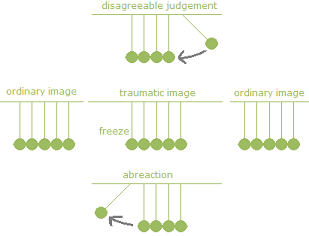The Kuriki method (the first edition in 2007) is a theory about Tourette’s syndrome (tic disorder) and obsessive-compulsive disorder to cure these diseases without medication. This theory is based on the author’s inference and interpretation regarding the structure of these diseases. Since it has been written for the psychoanalysts, reading will be difficult for people in general and it might be sometimes read erroneously. Therefore the Kuriki method must presuppose that the patient is treated by a nearby psychoanalyst, and that, between the patient and the Kuriki method, there is always the psychoanalyst. The explosion of emotional catharsis, which has strong repercussions, is done only for three seconds, once a week: beyond this rhythm, it would be an accident caused by negligence, and the psychoanalyst who is inexperienced in emotional catharsis must take responsibility for the temporary mental collapse caused by the accident. Also, to the patient who has weak capacity of logical reasoning, the psychoanalyst must explain well on the violent emotion of revenge caused by the illusory confusion between the person of the traumatic image in his head and the person in the real world.
Cure for Tourette’s syndrome (tic disorder) and OCD without medication
§32

Libidinal level since early childhood.
There might be a dualism of sexual sentiment and genital sensation in early childhood and we would consider that there is no link between the sentiment for naked body of the opposite sex and the eventual good sensation of the genitals, and that only after having the idea about ??sexual activity, sexual sentiment and genital sensation will be associated and the Libido will connect sexual sentiment and genital sensation. However, in the opposite direction, as going back in time, it can be said that infant is a condition in which the Libido as vital energy and the Libido that is seeking bodily pleasure are united: bodily pleasure and sexual sentiment are one and same thing and are going to gradually separate one from another. Psychological traumas are considered as vital traumas at the libidinal level, which always exists.
If it is possible to assume that the word Tourette indicates a predisposition, it is correct to say; “I am Tourette, so I have a tendency to have a tic disorder and I need to do catharses.” The formation of a mass of emotion is the precondition for the presence of any psychological trauma. Psychological trauma is not the cause of the presence of a mass of emotion. Tourette is an innate tendency to repress, and disagreeable potential emotions will accumulate from the age of baby. When a mass of emotion has been formed, the quiet repetition of a daily event will be suspected as a libidinal trauma. It is the content of the mass of emotion that chooses a trauma.
N.B.
Originally, the word “trauma” is a word that refers only to the physical trauma, such as a serious injury. In psychoanalysis, the word “psychological trauma” began to be used at the time of Charcot, as being distinct from physical trauma. The phrase “psychological trauma is physical (bodily)”, it means that the content of psychological trauma is a physical event, or that the image of psychological trauma is a physical image.
Psychological traumas at the Libido level from the age of 0 to 5 years.
Baby is fully Libido. A libidinal trauma, which will be the cause of tic disorder, is already possible. The trauma is not a trauma in itself. Whatever childish content, if a mass of emotion is formed later, it will be a trauma. Also, it is possible that a disagreeable object, which was once already in the Conscious of the baby, will be repressed later with the growth of the function of repression. An scary thing of everyday life at the vital energy level of the baby, the Oedipus of the age of 5 and the repressed primitive sensations will remain repressed. The more the baby is small, the more the disagreeable emotion and the primitive sensations are together at the Libido level of the vital energy. Emotions are bodily expressions of judgments. Disagreeable emotion is libidinally disagreeable because it is bodily disagreeable and fear is a libidinal fear because it is a bodily fear.
Psychic traumas at the Libido level from the age of 5 to 10 years.
As psychological trauma is a sexual trauma or a genital trauma, psychological trauma must have a bodily image. For example, the judgment such as “the nakedness of an adult person is grotesque” is a very bodily judgment and if it is not expressed in the Conscious, it can be a psychological trauma. Sexual trauma for children of Tourette can be something like, for example, seeing the nakedness of an adult person, or being touched by an adult person, etc. Trauma as a cause of tic disorder must be calm and repeated everyday; a sexual or genital image. The accumulation of the disagreeable emotion of everyday results the formation of an enormous mass of emotion.
N.B.
While the adjectives “sexual” and “genital” are mentioned by the word “vital” at the libidinal level, the obscenity of the psychological trauma should not be interpreted in a neutralized way. The description that says that the psychological trauma depends on the sensitivity of the child would give the easiness to “serious” people to attribute to social pressures the content of the psychological trauma. The basis of psychoanalysis is to consider the trauma literally as something obscene for the child. However, seeing something physically grotesque everyday can be considered as libidinal, even if it is not sexual or genital. Something physically grotesque is obviously disagreeable, but if the child sees it since birth, this judgment can be repressed. It is also possible that, even if the same judgment becomes conscious when he has grown up, the judgment of the baby remains frozen as a mass of emotion.
